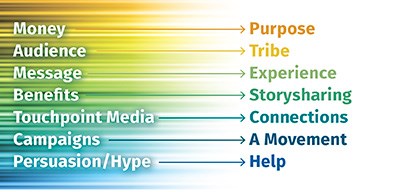From Hype to Help: Remaking Integrated Marketing Communications
It’s time to do something about that rickety, old, rough-running integrated marketing communications. And installing a few new parts isn’t going to do it. There comes a time when refining your approach doesn’t work anymore. You have to totally rethink and redefine what you’re doing and how you’re doing it. That time has come for integrated marketing.

By Gordon Hochhalter
Speaker, Writer, Consultant, Inspirer
Art Of It
It’s time to do something about that rickety, old, rough-running integrated marketing communications.
And installing a few new parts isn’t going to do it.
This Is Going to Take a Total Redo
It’s much like what our good friends at UNICEF faced a few years ago. They spent a fortune creating posters to promote the idea of child vaccination to the mothers of Rwanda.
The posters were gorgeous. Full of beautiful photographs of women and children with simple messages. Copy, written in Kinyarwandan, stressed the importance of vaccinating every child.
But There Was a Problem
It was a female illiteracy rate of over 70 percent. So the words written in Kinyarwandan, even if it was perfect Kinyarwandan, could not connect with them.
What to do? Tweak the photography to tell more of the story visually with simpler words? Refine the approach and reshoot the posters in comic book style that required almost no words at all?
So UNICEF started writing songs.
Songs?
Yes. It ends up that if you want to spread an idea in Rwanda you sing it.
One group of women would sing a song for other women. Not so much to send a message, but as a gift from one to another. It was the experience that counted.
The Moral
There comes a time when refining your approach doesn’t work anymore. You have to totally rethink and redefine what you’re doing and how you’re doing it.
That time has come for integrated marketing.
The World Has Changed
Message-driven marketing no longer works. As a result, IMC, as we know it, is in a world of hurt.
In fact, it is screaming for help louder than Roger Daltrey in thumbscrews.
And the answer is not to revise it. It’s to rethink it.
Rethinks
Here are six rethinks that will move IMC thinking from hyping people into creating tools that will help people.

1. From Audiences To Tribes
Tribes are everywhere.
Tribes you work with. Tribes you travel with. Tribes you buy with. Tribes that vote, that discuss, that fight. Tribes where everyone knows your name.
A tribe is a group of people connected to one another, connected to a leader, and connected to an idea.
This Is Different Than an Audience
Tribes are not about stuff and messages. Tribes are about connection.
Tribes are not determined by demographics or psychographics. They are defined by a shared worldview. That is, a common belief about how the world works, what’s important, what’s of most value. And what needs to be changed.
Biases Unite Us
This common view of the world connects tribe members together. And most importantly, it unites them all in a shared purpose. A cause that is grounded in changing something about the world.
The cause gives those who lead tribes a huge opportunity. An opportunity that’s bigger than messaging ever was.
It’s the unique chance to help the tribe by creating experiences that help them fulfill their cause.
2. From Messages To Experiences
For years, integrated marketing communications focused on describing the value that the organization created.
It did it through a sophisticated system of audience, message, media strategy, and brand touch points.
Describing Is Not Enough Anymore
The Internet came along and invited every organization and every dweeb with a smartphone to come on in and try to influence other people’s behavior by sharing information.

And lo and behold, every brand, every company and every Internet dweeb took up the invitation and came to the party.
All of them pushing messages out through more and more media outlets. Dumping talking points all over our heads through new technology.
Until we are so overwhelmed with messages, sound bites, information and just plain noise we can’t find what we value. It’s buried in a shit pile of media and messages. All professionally integrated together.
Don’t Describe, Create
Now the opportunity exists to create value using both content and experience. Not just describe it.
Today, that value is created by connecting tribe members to one another and to their common purpose and passion.
That happens through experiences. Not through messages.

Make Experiences, Tell Stories, Create Value
In a tribe, unique, impactful, experiences and the stories that emerge from them drive movements. And these tribe-driven movements change things.
As a result, the focus is no longer on messages and media.
Now, it’s about creating delightful experiences. The kind of experiences that engage, inform, and help the tribe do things they could not do on their own.
3. From Touch Pointing To Connecting
Touch points have always driven traditional IMC.
First, you defined all the areas where different segments of the audience came in contact with the brand. Then you assigned messages to each one.
Then you determined ways to link and integrate the touch point messages in such a way to move them to the next stage of decision-making.
The Old Pipeline and Funnel Trick
That was great when people had the time and the attention span to attend to all that messaging. And to follow the complex message maps organizations prepared to move them down the touch point pipeline.
That was before we started inundating people with sound bites, ridiculous claims, and a new offer every minute. Before messaging became a very weak way to move people.
Because messages don’t work anymore.
A More Human View
When you stop focusing on mass audiences that need to be prodded down the line of touch points the world starts to look different.
It starts to look like a human place where people naturally connect with others who share their passion.
Human Beings Can’t Help It
We need to belong.
One of the most powerful of our survival mechanisms is to be part of a tribe. To contribute to and take from a group of like-minded people.
We are drawn to leaders and to their ideas and we can’t resist the rush of belonging and the thrill of the new.
We Need Something Bigger
We want to belong to a community that stands for something bigger than ourselves.

In fact, we’re willing to become emotionally involved by connecting with others who share our purpose. We do this because we believe that together we are smarter than any one of us is alone.
High-quality connections like these are the glue that holds a tribe together.
We Need a Purpose
In large part, people join tribes to fulfill their need to feel connected. Tribe members need to feel connected to the tribe leader, to each other, and to the “tribal idea.” The cause.
The depth and the width of those connections determine the effectiveness of the tribe. The more tribe-member-to-tribe-member connections, the tighter the tribe.
4. From Internal Belching To Tribal Storytelling
It used to go something like this . . .
Figure out what made you different from your competitors. Then develop a sophisticated integrated media plan to get that idea across at every touch point with your audience.
And don’t forget to make message maps full of the facts and figures and rational that told people what to believe and what they should do.
Of course, all of this came from your internal point of view.
But the World Has Changed. Again.
We now live in a world of relative abundance. We are swamped with choices.
As a result, we are also swamped with more and more fragmented messages vying for attention on more and more fragmented media.
.
Traditional IMC contributes to this world of noise. It continues to encourage its users to create more messages that are essentially the same. From essentially the same internal view. Full of the same data-driven facts and figures and rationals.
It fails to recognize one very important thing.
We Do Not Want More Messages
We no longer find our way in the world by searching out information and messages that tell us what to think.

We want to be associated with people who provide us with unique experiences that appeal to our dreams and emotions. Experiences that add meaning to our pursuit of a better world. Experiences that encourage us to come to our own conclusion.
We want to be understood. Known for who we are as individuals.
Today, we navigate the world using symbols, visual expressions, shared experiences, and stories. These are the things that connect us with other tribe members and our common cause.
Stories Are the Currency of a Tribe
Narratives help shape the identity of the tribe. They give it values and boundaries and help establish its reputation.
They paint a picture of the tribe’s culture and values, heroes and enemies.
They define and give meaning to its cause.
By sharing our stories, we define who we are and what we stand for.
Leaders of tribes today establish their leadership by connecting people to each other and to their purpose. And they do it by telling stories.
5. From Campaigns To Movements
IMC campaigns are predominately based on four things. They are media, audience (demographics, psychographics and size,) messages, and touch points.
Media campaigns, even social media, are chiefly driven by messages.
And the messages are driven by telling people what to think and what to do.
But there’s a big difference between telling people what to do and inciting a movement.
Empower, Don’t Tell
Movements happen when people talk to one another. When ideas spread within the community. And most of all, when peer support helps people do what they believe is important and right.
So leaders create movements by empowering the tribe to do things through experiences. Then they help them share their experiences through stories.
They create platforms that people can use to make connections rather than commanding people to follow them.

Empower Who?
IMC programs market to a crowd they call an audience. Often the larger the better.
Movements assemble a tribe.
Instead of big numbers they seek highly committed tribe members. As few as a thousand true fans are all you need to have a powerful tribe.
There’s No Quality in Quantity
IMC campaigns care about numbers, not the quality of fans. They care about hits or turnstile clicks or media mentions.
Instead of always being on the hunt for one more set of eyeballs, movements see that the real win is turning a casual fan into a true one.
So the leaders of movements focus on tightening the tribe.
There’s Nothing Like a Tight Tribe
It’s tempting to make the tribe bigger, to get more members, to spread the word to one and all. But this pales with the effects of a tighter tribe. A tribe that communicates with speed, fervor, and emotion is a tribe that thrives.
A tighter tribe is more likely to hear its leader. It is more likely to coordinate action and ideas across the members of the tribe.
Fleeting vs. Enduring
IMC media campaigns are fleeting. They have a predetermined beginning and an end.

Movements last as long as it takes to make a difference.
This is an important distinction because the way you view the timeframe of your work dramatically affects the strategies you use.
As a result, leaders of movements help the tribe increase its long-term effectiveness in fulfilling their cause by:
- Transforming their shared purpose into a passionate goal and desire for change.
- Providing tools (experience platforms) to allow members to tighten their communications and tribe connections.
- Leveraging the tribe, not media, to allow it to grow and gain new members.
To do that they use three elements:
- A narrative that tells a story about who they are and the future they’re trying to build.
- A connection between and among the leader and the tribe.
- Something to do.
6. From Selling To Serving
Today’s connected marketplace, social networks, and interactions allow us to think differently about IMC.
We can create digital platforms that function as interactive integration hubs. These platform hubs connect people in a new, more engaging way than mere messaging.
The Rise of the Helping Platform
Most important, you can use these platforms to help your tribe. Help them do something that they want to do for the cause but aren’t able to do by themselves.
Something they want to do but can’t do easily. Something that makes a difference. Something that supports their purpose and propels the movement. Something that demonstrates the unique value of your organization to their cause.

How Serving Integrates
These interactive platforms have eight unique characteristics that make them especially powerful integration hubs:
- They are utilitarian. That is, they make it easy for the user to do something they already want to do.
- They are experience-based. They turn mere messages into digital experiences. They allow users to experience the meaning and attributes of the tribe.
- They are supported by earned social media programs that generate connections and dialogue. That feedback is used to refine and expand the platform over time.
- They generate stories that can be spread by the tribe and by earned media programs. And sometimes with paid campaigns when necessary.
- They are enduring. They are built to last and expand.
- They come in many shapes and forms.
- They embody the tribe’s passion and purpose. As tribe members interact with the platform, it reinforces the values of the tribe. But it also gives them something to do that advances the tribe’s purpose.
- It helps them do something they want to do and can’t do as well without the platform’s help.
Click here if you’d like to experience some examples of these interactive integrated platforms. It’s worth taking a minute to meet some of the pioneers on the new IMC frontier.
You’ll see how they help their tribe do something important. And that’s the idea. To do something. Not to say something.
But that’s just my opinion. What’s your take?
Gordon Hochhalter
Speaker, Writer, Consultant, Inspirer
Art Of It
312-933-4704
twitter@gordonhochhalte
linkedin.com/in/gordonhochhalter
About the Author
Gordon Hochhalter
Gordon inspires purpose-driven people to create movements that change the world. An unconventional, speaker/entertainer, storyteller, writer, and creative consultant, he travels the world prying open minds and hearts to a new way of seeing. Known for his ability to pollute the minds of the curious, he’s lectured and conducted storytelling workshops at Northwestern University, DePaul University, Loyola University, the University of Iowa and the University of Chicago, professional conferences, and individual firms. Gordon has written six little books on the dramatic, changing nature of communications. And he’s won more than 450 creative awards for his work with over 100 organizations worldwide. Some of his work can be found in the permanent collections of The Library of Congress, The AIGA Design Archives and The University of Chicago Library. He attributes this to his unique ability to take credit for other people’s work.


